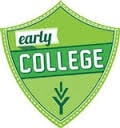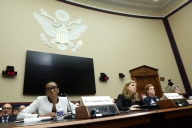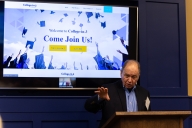You have /5 articles left.
Sign up for a free account or log in.

ivytech.edu
Dual enrollment -- in which high school students can take college courses and earn credit before graduation -- has grown rapidly in popularity in recent years. After all, students can earn college credit for free, be exposed to higher education and gain confidence in their ability to do college-level work. Colleges benefit from the additional students, who may enter their halls already prepared and able to move through to graduation.
But an accreditor is raising questions about whether some of these high school teachers have the proper credentials to offer college-level courses.
A policy clarification by the country's largest regional accreditor, the Higher Learning Commission, has many of the colleges and high schools within HLC's 19-state, Midwestern jurisdiction scrambling to get their teachers, and some college professors, up to par.
HLC's clarification said that high school teachers in dual-credit courses, along with all instructional college faculty, must have a master's degree in the specialty they're teaching, or they need at least 18 graduate-level credit hours within that specialty. Colleges have until September 2017 to assure that any high school teachers with whom they work meet such requirements. Many of the high school teachers leading dual enrollment courses may either have just a bachelor's degree, or a master's degree in education, but not in the subject matter they're teaching. Some states within HLC's jurisdiction, like Arkansas, are already in compliance with the guideline, so their programs aren't affected by the change. (Advanced Placement teachers aren't affected because they aren't affiliated with colleges in which their students later enroll. Colleges that award credit do so on the basis of AP exams.)
"We do not believe if a student is in a course in high school for college credit that they should be offered anything at a substandard level. They should have teachers with the same qualifications as college faculty," said Barbara Gellman-Danley, president of the Higher Learning Commission, which is based in Chicago.
Some students in dual enrollment, also known as concurrent enrollment, programs have been known to complete their first year of college or achieve an associate degree before their high school graduation. According to a 2013 report from the National Center for Education Statistics, nearly 15,000 public high schools enrolled students in college courses in 2010, and from 2002 to 2011, dual enrollment had an annual growth rate of over 7 percent.
The education requirements have always been an expectation of HLC, but over time the commission found that some colleges were not complying or, they were "taking too much of a soft touch" with the guidelines about the high school teachers with whom they work, Gellman-Danley said.
Because dual enrollment courses are often built by college faculty, it's the responsibility of the professors and colleges to make certain the high school teachers offering these courses have the right credentials.
College in High School
The requirements have rocked some states, colleges and schools that offer widespread dual enrollment programs. Indiana, in particular, is grappling with the guidelines on a statewide level mostly due to two issues -- state law and growth. The state has about 3,000 dual credit teachers who offer 3,500 courses.
"This whole issue has exacerbated a problem we already had, and that is the pending shortage of dual credit teachers," said Teresa Lubbers, Indiana's commissioner for higher education.
Nearly 10 years ago the state passed a law requiring every high school to provide at least two Advanced Placement and two dual credit courses. Ivy Tech Community College of Indiana -- the only statewide community college in the country -- has the majority of partnerships between its campuses and the state's local high schools.
The college expects the changes to affect 200 high schools that provide dual enrollment courses with Ivy Tech, said John Newby, Ivy Tech's associate vice president of K-12 initiatives. Ivy Tech alone offered dual enrollment courses for about 52,000 high school students in 2014-15 school year.
"Based on the numbers, well over half of those agreements will be in jeopardy unless we can find ways to get those teachers up to speed and fall within the framework of guidelines by September 2017," he said. "A lot of teachers have a master's degree, but they have them in education. They simply do not have the requisite hours of graduate study in content area that's being expected under those guidelines, and that's not unusual."
There are anywhere from 600 to 800 credentialed dual credit high school faculty members, he said, although they are still analyzing and gathering data on how many will be directly affected.
HLC isn't requiring teachers in career and technical education to meet the minimum education requirements, and about 60 percent of dual credit courses offered through Ivy Tech are in career and technical fields, Newby said.
Prior to enforcing the requirements, colleges often looked at other factors outside of HLC's requirements to determine if a teacher could instruct in a dual credit course.
"We had flexibility built in that allowed institutions like ours to consider other things that we thought were important in terms of determining whether or not a teacher was qualified," Newby said, adding that those qualifications could include years of experience in the field, content hours including graduate work spent in the subject, or participating in professional development opportunities. "That didn't equate to graduate credit hours, but it did equate to what we felt was important to making a teacher a good teacher."
"We thought there were safeguards included in how we were doing this that made it appropriate," he said.
They are also in the process of conducting an audit of on-campus college faculty members who will be impacted by the requirement, Newby said, although it will have less impact.
Last week, Minnesota lawmakers held a joint House and Senate hearing to address concerns over the changes and the impact they will have on dual enrollment courses, particularly in rural schools. Gellman-Danley attended that panel and allayed some of the fears, said Sandy Connolly, director of communications for Minnesota Office of Higher Education.
Although HLC is requiring all of their colleges to meet the standard by September 2017, many of them may have more time than that based on the timeline for their next accreditation evaluation. For example, after Sept. 1, 2017, if any institution undergoing a comprehensive evaluation by HLC is not in compliance with the requirement, they have three months to submit a plan that would outline when they will be in compliance within two years, Gellman-Danley said, adding that HLC also doesn't want this scenario or something similar to become common practice.
"We're in a much better position to expect our institutions to comply with this," she said. "And we want them all to be in compliance in two years."
But during that panel, college professors, teachers and students expressed fear that the requirements would eliminate the programs they believe have helped in closing the achievement gap and led to graduation.
Having a master's degree or a Ph.D. doesn't mean anyone is a better teacher, and HLC hasn't been able to show the research or the proof that these additional graduate credits are needed, said Joe Nathan, a former Minnesota teacher and director of the Center for School Change, which works to improve high school and college graduation rates.
"We're hearing a 1950s view [from HLC]. We should focus on the collaboration between high schools and colleges that help students rather than a rigid expectation about credentials," Nathan said, adding that the program is helping to close the achievement gap in the state.
From 2009 to 2013, Minnesota has seen a more than 50 percent increase in students of color participating in dual enrollment courses and a 40.6 percent increase during that same time for students who qualify for free or reduced lunch, according to the Minnesota Department of Education.
In a report on four-year graduation rates, the state found 88.2 percent of African-American students who took one or more Post Secondary Enrollment Options or a dual enrollment course graduated, compared to a 57.8 percent graduation rate for all African-American students. Over all, for students who took one or more PSEO or a concurrent course, the rate was 97.4 percent compared to 79.8 percent for all students. PSEO courses are those taken directly on a college campus by an enrolled high school student.
But Josh Collins, the MDE's director of communications, cautioned that the statistics on graduation rates of PSEO or dual enrolled students don't point to a direct causality and they don't measure if being a dual credit course taker directly leads to higher graduation rates. So being in a dual enrollment course doesn't mean a student has a higher chance of graduating and there is an argument that these students would have been successful anyway, he said, adding that it also doesn't diminish the benefit of the program, which helps these students complete college faster and at a lower cost.
Minnesota ranks in the top five states of the country in student debt, and dual enrollment has been able to help students keep college tuition costs low. Statewide last year, the program helped save about $40 million in college credit, said State Senator Carla Nelson, a Republican from Rochester who sits on the state's Higher Education and Workforce Development committee.
"HLC has made an error and I'm not going to say, 'OK, let's accept and deal with it,'" said State Senator Terri Bonoff, who also chairs the state's Higher Education and Workforce Development committee and is a Democrat from Minnetonka. "We have been doing concurrent enrollment for a long time (about 30 years) and successfully. We have research and data that shows when students participate in our concurrent enrollment, they graduate high school at higher rates and they go to college with fewer debts."
Bonoff said the state legislators will be sending HLC a formal request to change their viewpoint. She also is a commissioner for the Midwestern Higher Education Compact -- a nonprofit regional organization that works to improve access to higher education -- and expects there to be a panel on this topic at the organization's November meeting.
HLC couldn't provide any research to the Minnesota legislators or Inside Higher Ed showing problems with current dual enrollment teachers.
But Gellman-Danley said it has long been the practice of faculty in higher education that they control the curriculum, put together the syllabi and are experts in their discipline. Those additional credentials help validate their expertise and ensure students have a faculty member with college-level expertise in the subject matter.
"We're not identifying this as a problem. It's a practice that's been in place a very long time and while we believe in outcomes, let's be honest. In this country when it comes to assessment and outcomes, we're not there yet. It's a good goal and we're getting there, but the coin of the realm in higher education, in its history, has been a disciplined expertise," she said during the hearing with Minnesota legislators. "We don't feel [students] should get less of an education than they would in college."
During the hearing, Gellman-Danley also added that there is concern about the transfer of dual enrollment credits to universities across the country that may not accept those credits because they don't feel confident in the credentials of the teachers in those courses.
Credentials in Other States
The Southern Association of Colleges and Schools, which is the regional accreditation body for 11 states, has had the same requirement -- master's degree or at least 18 graduate credit hours in the subject area -- for dual credit instructors for decades, said Adam Lowe, executive director of the National Alliance of Concurrent Enrollment Partnerships.
"The other regional accreditors have far less specificity regarding faculty qualifications, but most say they should have a degree at least one level higher than what they teach or at least some academic course work relevant to the field they teach," Lowe said. "In other regions the determination of what constitutes a qualified faculty member is left up to the institutions and some states have standards in place."
The major takeaway from this should be that institutions need to apply the same requirements for dual enrollment instruction that they would apply on campus, Lowe said.
For those states and colleges that find themselves out of compliance, there are meetings and discussions happening to get these teachers, and some college faculty members, the credentials they need.
Ivy Tech, for instance, has been in discussions with Indiana's four-year universities and the school districts on how to "ramp up" the graduate offerings and identify the course areas where the additional credit hours or degrees will be needed.
Newby said Ivy Tech is admittedly at a disadvantage, because unlike the four-year universities in the state that also host dual enrollment programs, the community college doesn't have the ability to offer graduate-level courses for its high school instructors.
But that is a part of a myriad of issues -- paying for the additional credit hours, encouraging high school teachers to participate, meeting the 2017 deadline -- that still need to be worked out and that led to the state reactivating its Dual Credit Advisory Council.
"This is an ongoing discussion and predicated on the fact that we believe dual credit is a good way to get students better prepared for college and save families money," Lubbers said.








